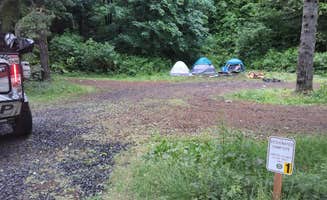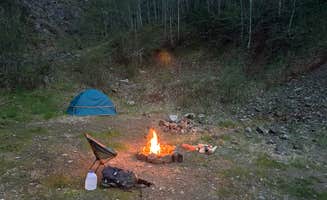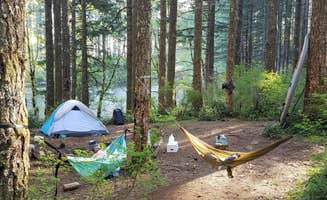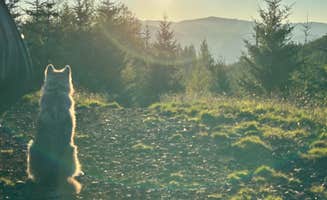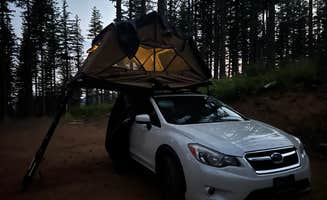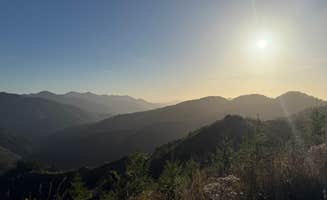Dispersed camping near Dundee, Oregon primarily centers on Tillamook and Siuslaw National Forests, with elevations ranging from 700 to 4,000 feet. Access typically requires driving 30-45 miles west through increasingly narrow forest roads that deteriorate in quality as you progress deeper into public lands. Most sites experience significant temperature drops at night, often 15-20 degrees cooler than daytime highs even in summer months.
What to do
Fishing opportunities: At South Lake Dispersed Area, campers can enjoy stocked trout fishing with relatively consistent success. "The lake is stocked with trout which have been biting like crazy. Most times when you go up there you will see them jumping clean out of the water," notes one regular visitor. The lake is small but productive for anglers.
Kayaking: South Lake provides calm waters ideal for small watercraft exploration. "The small lake has decent fishing and great for kayaking," mentions a reviewer. While the launch area can be muddy, the compact size makes it manageable for paddlers of various skill levels.
Hiking: The Pioneer-Indian Trail offers multiple access points to explore the forest. "Going up the hike about 30 minutes will bring you to the top of Mt. Hebo with beautiful open views all the way to the coast. The hike goes all the way to South Lake." This trail system connects several camping areas and provides day-trip options from base camps.
What campers like
Solitude during weekdays: Weekday visits significantly increase chances of finding empty campsites. "When i visited mid week in July it was empty," reports one South Lake visitor. Similarly, at Trask River Campsites, campers note: "If you go earlier in the week, you'll most likes find a spot with no problem. If you wait till Friday evening during the summer, it'll probably be full."
Night sky viewing: Clear nights offer exceptional stargazing due to minimal light pollution. "Clear skies so got to see a beautiful array of stars," reports a Trask River camper. Higher elevation sites provide additional advantages for astronomy enthusiasts.
Natural soundscapes: The sound of flowing water creates natural white noise at riverside locations. "River rushing near the spots makes for a really nice sound to fall asleep to," notes a visitor to Trask River Campsites. These ambient sounds help mask occasional distant vehicle noise.
What you should know
Cell service variability: Coverage changes dramatically across the region. At Tillamook State Forest Dispersed Camping, "ATT/Verizon service is nonexistent in the area." However, at other locations: "Had 3 bars of LTE with AT&T once there." Always plan communications assuming no service.
Road conditions: Forest access roads require careful navigation. "The road to get there was about 12 miles of dirt/gravel but when I left, only had dirt roads for 3 miles." Routes often change seasonally, with washouts or logging operations redirecting traffic.
Target shooting activity: Several areas experience frequent shooting. "There appeared to be a few semi-permanent campers along the route... and has been used as a drug-up spot." Some dispersed sites show evidence of target practice, with clay pigeons and shells left behind.
Tips for camping with families
Best timing for quieter experiences: Early season camping offers fewer crowds. "This free campground is just far enough out from the coast and the city that you'll likely be alone, even on a Saturday night." Weekdays from May through early June provide optimal conditions for family camping.
Water safety considerations: Lakes and rivers require supervision. "The lake is small but very beautiful. We did bring our kayaks but didn't launch them. It's pretty mucky and there are a lot of downed trees in the water." Children should wear life vests near all water features.
Site selection for privacy: Look for sites with natural buffers between neighbors. "This was a really fantastic campsite! Definitely quite the long and slow drive up a narrow backcountry road - steep in sections but overall quite manageable. There are a few options up here but one really phenomenal site with wide ranging views." Sites at higher elevations often provide more separation.
Tips from RVers
Turnaround challenges: Most forest roads lack proper turnarounds for longer vehicles. "If you're telling something, I'd recommend walking the road to check to see if anybody is down there before you go down because it's the only place you'd be able to turn around with your trailer." Scout ahead before committing to narrow roads.
Clearance requirements: Many access roads demand high-clearance vehicles. "The road up was a very narrow road. So careful if there's other cars coming through, especially the logging semis." Most dispersed sites require at least 8-10 inches of ground clearance for safe access.
Seasonal timing: Spring access often remains restricted. "Went up at the end of the snow season and I couldn't quite make it. My 4wd rav only has road tires and I eventually got to a point I wasn't able to make it." Plan RV trips between late June and September for optimal road conditions when accessing North Fork Trask and other higher elevation sites.


